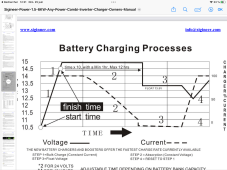Hello! I faced an issue whith a new back up system (combo battery inverter - on main power) for a well pump (1,5 HP, 10 gpm). The well pump is the only load.
the inverter was set at 9...cv 50.25, no float...the battery was getting slowly charged no issue...(inverter on main, with priority to main).
however, at the moment the battery got full, the inverter alarm went off and I got a message that the inverter went in overload.
I tought that the invertor would go in floating mode? It appears the keep trying to charge the battery?
what should Indo?
battery is Renogy 48v, 50 amp
inverter is sigineer 48 v,6000 watts
the inverter was set at 9...cv 50.25, no float...the battery was getting slowly charged no issue...(inverter on main, with priority to main).
however, at the moment the battery got full, the inverter alarm went off and I got a message that the inverter went in overload.
I tought that the invertor would go in floating mode? It appears the keep trying to charge the battery?
what should Indo?
battery is Renogy 48v, 50 amp
inverter is sigineer 48 v,6000 watts




